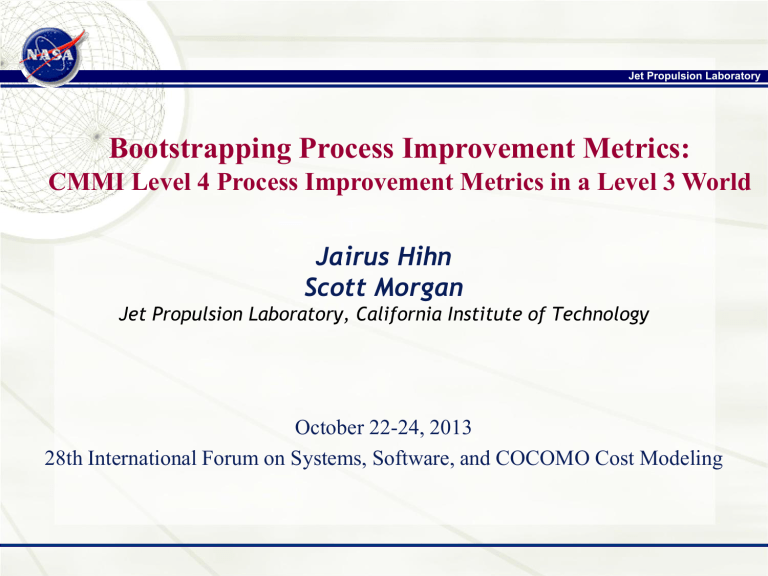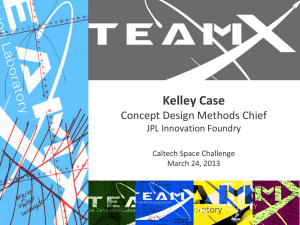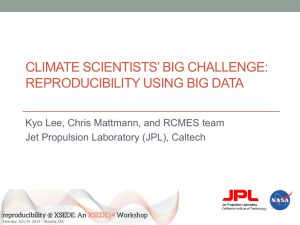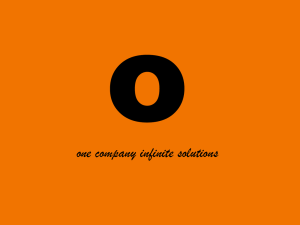Bootstrap-Process-Improvement

Jet Propulsion Laboratory
Bootstrapping Process Improvement Metrics:
CMMI Level 4 Process Improvement Metrics in a Level 3 World
Jairus Hihn
Scott Morgan
Jet Propulsion Laboratory, California Institute of Technology
October 22-24, 2013
28th International Forum on Systems, Software, and COCOMO Cost Modeling
Background
The Jet Propulsion Laboratory (JPL) is a Federally Funded Research &
Development Center (FFRDC) operated by the California Institute of
Technology for the National Aeronautics and Space Administration
(NASA).
JPL has around 5000 employees
As part of the NASA team, JPL enables the nation to explore space for the benefit of humankind by developing robotic space missions to:
Explore our own and neighboring planetary systems.
Search for life beyond the Earth's confines.
Further our understanding of the origins and evolution of the universe and the laws that govern it.
Enable a virtual presence throughout the solar system using the Deep Space
Network and evolving it to the Interplanetary Network of the future.
2
Background (cont.)
The Software Quality Improvement (SQI) Project at
JPL has been in existence for about 11+ years and with the increasingly tight budgets more and more managers wanted to know
• Aren’t you done yet
• What are we getting for all of this money
Textbooks and the Carnegie Mellon Software
Engineering Institute (SEI) often promote the measurement of changes to well defined baseline indicators, pre and post the process change
•
• For example, use of process control charts and measuring changes in the control limits.
This type of approach works well for CMMI Maturity Level 4
& 5 organizations.
3
SQI is trying to perform ‘like’ a CMMI Level 4 organization
Capturing product knowledge systematically as well as process knowledge
Using data to guide day-to-day decision
Setting priorities
using rigorous statistics where appropriate
4
When in reality JPL is assessed at CMMI Level 3
Do our best to capture product and process knowledge
There are pockets of Level 1 and 2 behavior
Tools are not standardized
A great deal of flexibility is permitted to the projects
Data is inconsistent
Using data to guide decision when we can
5
So What Can We Do?
Put infrastructure in place
Drive decisions with objective information and data when available
Must use a multi-pronged approach
• We do rely heavily on self reports
Communicate results as widely as possible
•
•
•
• State of Software Report
Noontime seminars
Management reviews
Section manager quarterly meetings
6
Key Questions
What does our software world look like?
How are we doing?
How can we improve?
How much software is there and what are its characteristics?
How many software engineers are there and what are their characteristics?
How are our projects doing?
• Documenting Baselines and Trends
Are we following our processes?
Where should we invest limited resources for process and product improvement?
• Identifying weaknesses
• Deriving Impact Measures
7
Data Sources
Data Sources
•
•
•
•
•
•
•
•
Metrics Collection at Key Milestones
Software Inventory (2006, 2007 and 2009)
Process performance measures (Tailoring Record, Work Product Checklist)
Defect tracking systems (PRS, ISA, AAMS, local databases)
JPL Human Resources Information System
SQI Surveys and Contact Log
Product and Process Quality Assurance Activities
Customer Feedback
Data is gathered from virtually all mission software teams
• We would like to thank the several hundred people who gave their valuable time to make this data available
8
What does our software world look like?
9
Did you know?
The JPL Engineering and Science Directorate is one of the 500 th largest software organizations in the United States
Based on comparing JPL labor costs to company revenues for software products and services then according to the 2007 US economic census we may even be in the top 250
We compare to Disney and Lucas Arts and are smaller then
Rockwell Automation
We are cognizant over 53 million lines of code representing an investment in the neighborhood of $2.7 billion
There are currently 36 million lines of code in development or maintenance directly supporting our projects which is
supported by 464 work years per year or approximately $136 million annually
Mission Critical and Mission Support Software only
10
Software Characteristics
LOC Distribution by SW Classification
Class C -
Mission
Support
56%
Class B -
Nonhuman
Space
Rated
44%
2 0 0 9 I nvent ory -
Percent age of Act ive Task s by Task Size
Large ( 4 - 1 0
W Y)
8 %
Very Large
( > 1 0 W Y)
1 %
M edium ( 2 - 4
W Y)
1 6 %
Sm all ( 0 - 2
W Y)
7 5 %
How Much Software? (cont.)
Our data indicates that the majority of software tasks were small ground maintenance tasks while we were focusing on large flight development tasks.
Decision
We modified our focus to include addressing the needs of small tasks
12
Fortran
26%
Software Implementation Languages
Other
2%
Python
2%
Languages Used
Scripting Languages
10%
Java
9%
C
36%
Since 2007 primary change is in
Ground Software
Increasing use of scripting languages
Decrease in C++ and Java
Small increase in Fortran
C+ +
15%
What are Primary Languages? (cont.)
So if we want to introduce new language specific tools to impact software quality, the data enabled us to identify that C and Java tools should be addressed first.
Decision
We defined focused consulting tasks to introduce the static code analyzers to the software community
•
• Coverity Prevent for C
Findbugs for Java
14
How are we doing?
Are we following our processes?
15
Establish Policies, Standards and Processes
Flight Project
Practices (FPP)
CMMI SDR
·
Other JPL & NASA Standards
·
Corrective Action Notices
·
Failure Reports
·
Lessons Learned
·
JPL Best Practices
Tailoring Instructions for the SDSPs
Software Development Standard Processes (SDSPs)
SW Management Processes SW Engineering Processes SW Support Processes SW Assurance Processes
Procedures Classes Seminars Examples Sample Text Compliance Matrices Measurement Repository
Templates
Local Procedures
Project Standards
(e.g., SCD)
Project
Requirements
Project SW Plans and Procedures
Software Development Standard Processes (SDSP) Applicability
The SDSPs describe how mission software tasks are expected to perform their software development activities
•
•
• All mission software tasks must start with the SDSPs as a basis for the activities they will perform
Software tasks then modify the SDSPs to fit their particular task, based on task characteristics such as size, risk, domain, etc.
Task-specific modifications of the SDSPs must follow
published procedures. The modifications are reviewed by task management, line management, Software Quality
Assurance (SQA), and SQI. They are then approved by the
Process Owner.
17
Process Performance
Process Performance questions
•
•
• Are we following our processes?
How does process performance vary by software characteristics?
What are the least performed processes ?
• What process areas should be targeted for improvement?
•
•
•
•
•
Process Performance is measured by responses to the
Tailoring Record (TR),
Work Product Checklist (WPC),
Tailoring Record Review (TRR),
Software Process Review (SPR)
Product and Process Quality Audits (PPQA)
18
Measuring Process Performance
The WPC provides a quick look as to whether 60 key products identified in the SDSPs are being developed
TR and TRR provide risks, strengths, recommendations at planning stage
SPR asks the question: based on the processes you planned to use “How are things working for you?”
Specifically:
•
• Are your processes effective? (That is, did you accomplish the process objectives?)
Have any processes been descoped?
• Are your resources adequate? (That is, were resources adjusted significantly different from plans?)
19
Overall Process Adherence
Process adherence is measured via the Tailoring Records and the WPC
WPC – Work Product Checklist
63 products and activities that a task should be expected to perform
PPI – The Process Performance
Index is a measure of adherence to the JPL SW Development
Standard Processes
Do not expect 100%
Some activities are not appropriate for all types of tasks
PPI has slightly increased since
2007
W PC Com plet ion Percent ages by Class
All W PC Ta sk s
Slope - Percent age of
Done/ Ex ist s or Planne d
Responses
90%
80%
8 5 %
18 tasks
7 5 %
47 tasks
70%
60%
50%
6 9 %
29 tasks
Class B Tasks
Class C Tasks
All Tasks
40%
30%
20%
10%
Increased process adherence
20
Overall Process Adherence
What are we really good at?
Configuration Management
Tracking schedules
Testing and Delivery
Areas of significant weakness
Documenting and reviewing software reuse assumptions
Basis of estimate (BOE)
documenting our assumptions and methods
Using data and models
Keeping risk lists up to date
21
Activities perceived as useful but under performed
Cat egor y Quest ion Text
Implementation Utilize a static code analysis tool
Implementation
Implementation
Design
Configuration
Management
Bi-directional trace of requirements to software test cases
Code commenting standard (may be part of coding standard)
Documented data specification that includes meaning, relationships to other data, origin, usage, and format (typically referred to as a data dictionary)
Verify and document that CM system is working properly (sometimes called a
Configuration Audit)
Implementation
Critical software units are peer reviewed (a critical software unit provides functionality vital to the performance of the software product or is identified as safety critical)
Design
Implementation
Software
Management
Documented detailed design
Unit test cases are developed and under configuration management
Collect and analyze metrics data (other than cost, workforce, and schedule) (examples include defect, requirements, and test metrics)
Percent age
Valuable
84%
78%
Percent age
Done or
Planned
58%
54%
84% 62%
85%
82%
88%
91%
98%
80%
64%
61%
70%
74%
83%
65%
22
Indicators of the Impact of Process Improvement
23
Metrics as Evidence
Nine months ago Bill Taber a 343 TGS (and a fellow metrics freak)sought to address a common question: “Is all this software process stuff worth the cost?”
Data for two development teams:
Legacy Mission Design Software (MASL), Next Generation Navigation Software
(MONTE)
Similar experience, technology, domain knowledge, development skills, productivity (as measured in terms of lines of deliverable code/developer.
Dramatically different processes:
One disciplined (CMMI ML3),
The other whatever developers felt like doing.
Quality Measures
Defect density as a measure of quality as experienced by users
Comment density as a measure of quality experienced by developers who have to maintain the software
Using metrics available for both tasks we can see how much extra the “high quality process” costs.
24
The Impact of Process
Project Process
Performance
Index (*)
Defect
Density
(bugs/
Ksloc)
Productivity lines of code/day/ developer
Comment
Density
(comments/ sloc)
Legacy Mission
Analysis
(minimal process)
Next Generation
Navigation SW
(rigorous process)
33%
90%
11.74
3.06
25
30
0.37
1.06
* - Measure of adherence to the JPL SW Development Standard
Processes
Task with more robust process had 74% fewer defects for every 1000 lines of code and was 20% more productive.
Comparison is for period from July 2005 to July 2007
25
Impacts of Using
Process & Product Standards* - 1
Projects with disciplined processes exhibit
A 47% higher productivity rate on average than those with moderate to minimal process performance
Productivity rates equivalent to DOD benchmarks
Flight Software Key Process and Product M etrics
Process Performance
Effort Growth from PDR
Productivity
(Lines of Code/
Work M onth)
Defect Density
(Defects/
Thousand Lines of
Code)
Robust Process 39% 150 4.3
Low to M oderate
Process Performance
116% 106 5.9
26
Baselines and Trends (cont.)
Doing our best to track these for last 6-7 years
Primarily documented in the State of Software Report
“Effort Growth from PDR” chart has had significant impact on managers perceptions
We continue to seek more and better quantitative indicators
However, these types of metrics change slowly and are impacted by many factors
Decision
We introduced an approach to quick short term impact indicators based on Customer Contact and Recommendations Tracking
27
How many software engineers are there and what are their characteristics?
28
The Software Community
There are approximately 900 people in the software community
This includes managers and systems engineers who oversee software development and maintenance tasks
Software is developed across many Sections(Branches) and touches every Engineering Division
Less than 33% have formal software degrees
Decision
JPL is implementing a software certification program for flight software developers to make certain they have the appropriate formal software training
29
Wrap Up
We continue to work to get hard quantitative indications of impact of SQI and process improvement
• In 2014 we will do the third State of Software Report and each time we are ably to improve the metrics content
It is better to move forward with ‘measurement’ as best you can because
•
•
• Partial results cause customers to ask for more and be more willing to provide assistance
We better understand the barriers
Learning how to do it better
30
Acknowledgements and Reports Available
This work was carried out at the Jet Propulsion Laboratory, California Institute of
Technology, under a contract with the National Aeronautics and Space
Administration. © 2013 California Institute of Technology. Government sponsorship acknowledged.
This work would not have been possible without the support of John Kelly in the
NASA Office of the Chief Engineer and the JPL Engineering and Science Directorate
Detailed report is available
J. Hihn, S. Morgan et. al., ESD Mission Software: State of Software
Report 2011 External Release, JPL D-29115, June, 2012.
31






